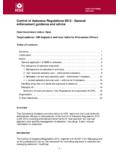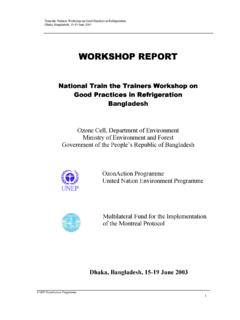Transcription of Production Standards - FL
1 Training the Industrial Athlete of the Future Production Standards August 2007 Update Manufacturing Skills Standards Council 1410 King St. Alexandria, VA 22314 MSSC Copyright 2007 2007 by the Manufacturing Skill Standards Council 2 Background In 1998, the federal National Skill Standards Board (NSSB) officially recognized the Manufacturing Skills Standards Council as the Voluntary Partnership for Manufacturing under the terms of the National Skill Standards Act. The MSSC was responsible for building a nationwide system of industry-led, core skill Standards , assessments and certifications for Production and Production support workers (entry-level thru first-line of supervision) in all manufacturing sectors.
2 MSSC built Standards in six industry-wide technical competency areas or concentrations. In developing nationally validated, legally defensible Standards , the MSSC involved 700 companies, 4,000 workers, 350 subject matter experts, and some $9,000,000 in public funds and in-kind industry contributions. In 2001, the NSSB formally endorsed these MSSC Standards . Subsequently, the MSSC has developed a nationwide system of curriculum, assessment and certification based upon the Standards for the Production concentration, leading to a MSSC-Certified Production Technician (CPT) credential. According to the Department of Labor s Occupational Outlook, there are now about 7 million individuals in manufacturing Production occupations, more than half of the total number of manufacturing jobs in the In 2007, the MSSC updated its original Production Standards to ensure that they reflect the skills and knowledge used today in high-performance, advanced manufacturing workplace.
3 This update involved teams of subject matters experts and review by over 250 companies representing all manufacturing sectors. The updated Standards , completed in August 2007, continue to be organized around the MSSC s original four critical work functions of Production : Safety Quality Practices and Measurement Manufacturing Processes and Production ; and Maintenance Awareness. The Standards for each of the four functions are organized under two headings: Work Standards - These define the key activities and related performance indicators that represent the work carried out. Worker Standards - These define the basic technical knowledge and skills required by a mid-level Production technician to perform the work.
4 2007 by the Manufacturing Skill Standards Council 3 Table of Contents Safety Page Work 4 Worker 7 Quality Practices & Measurement Work 11 Worker 14 Manufacturing Processes & Production Work 17 Worker 20 Maintenance Awareness Work 22 Worker 24 2007 by the Manufacturing Skill Standards Council 4 MSSC Work Standards SAFETY Key activities and Performance Indicators 1. Work in a Safe and Productive Manufacturing Workplace a. Ways in which manufacturing affects the national and global economies are recognized b. Systems of safety used by high-performance manufacturers to produce quality products at lowest possible costs are recognized c.
5 Role of Production workers in helping to ensure competitive levels of cost, quality and delivery in a safe work environment is identified d. External and internal customers are identified. 2. Perform safety and environmental inspections a. Potential hazards in the work are identified, reported and monitored b. Corrective action is taken to eliminate potential hazards c. Health, safety and environmental documentation and policies are thorough and regularly reviewed d. Inspections meet all relevant health, safety and environmental laws and regulations e. Inspections are performed according to company schedule and procedures f. Inspections are documented g. Inspection records are stored correctly.
6 3. Perform emergency drills and participate in emergency teams a. Training and certification on relevant emergency and first aid procedures are complete and up-to-date b. Procedures for responding to fire and electrical emergencies are clearly defined 2007 by the Manufacturing Skill Standards Council 5c. Emergency response complies with company and regulatory policies and procedures d. Emergency drills and incidents are documented promptly according to company and regulatory procedures 4. Identify unsafe conditions and take corrective action a. Conditions that present a threat to health, safety, and the environment are identified, reported, and documented properly b.
7 Corrective actions are identified c. Appropriate parties are consulted about corrective action d. Corrective actions are taken promptly according to company procedures e. Ongoing safety concerns are tracked and reported until corrective action is taken 5. Provide safety orientation for all employees a. Orientation covers all topics and procedures needed to facilitate employee safety b. Orientation identifies needs and processes to raise safety concerns, ask questions, and receive additional training c. Orientation is provided on use of personal protective equipment d. Orientation is documented according to company requirements e. Orientation meets all relevant laws, policies and regulations f.
8 Safety training is delivered regularly 6. Train personnel to use equipment safely a. New operators are given a complete orientation to the equipment and guidelines for ergonomic safety b. All important information regarding equipment safety, including material handling equipment, is communicated clearly and effectively c. Suggestions regarding training materials and content are made to the correct parties d. Evaluations and feedback are utilized to improve training materials and methods e. During training, trainee has the correct tools to do the job f. Post-training evaluation indicates that workers can operate equipment safely g. Training and facilitation techniques used are appropriate for trainees h.
9 Quality and effectiveness of training are documented appropriately 7. Suggest processes and procedures that support safety of work environment 2007 by the Manufacturing Skill Standards Council 6a. Health and safety representatives are consulted in the development of suggestions b. Operator feedback is solicited and used to create a safer, more effective work environment c. Suggestions are made to correct parties, according to company procedure d. Suggestions are properly documented e. Content of suggestions appropriately responds to safety, quality and productivity issues 8. Fulfill safety and health requirements for maintenance, installation, and repair a.
10 Communication regarding safety is made regularly to all employees b. Job safety analyses are reviewed regularly according to company policy c. Hazardous materials procedures and policies, such as Material Safety Data Sheets (MSDS) and right-to-know, are accurately followed d. Environmental testing of workplace is performed on a regular basis as required by company policy and regulation e. Equipment is audited to ensure there are no by-passes of safety guards f. All regulatory and company safety procedures are followed, including those related to lock-out/tag-out, confined space, and ergonomics g. Good housekeeping procedures are followed 9. Monitor safe equipment and operator performance a.



